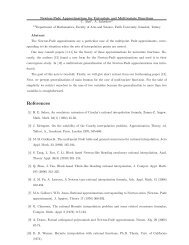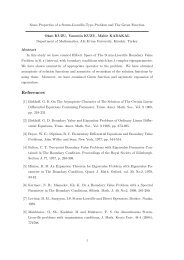Download Abstract Book - the ICAAM 2012 Conference in Gumushane
Download Abstract Book - the ICAAM 2012 Conference in Gumushane
Download Abstract Book - the ICAAM 2012 Conference in Gumushane
You also want an ePaper? Increase the reach of your titles
YUMPU automatically turns print PDFs into web optimized ePapers that Google loves.
Boundary Value Problem for a Third Order Partial Di¤erential Equation<br />
A. Ashyralyev 1 ; N. Aggez 1 ; F. Hezenci 1<br />
1 Department of Ma<strong>the</strong>matics, Fatih University, 34500 Istanbul, Turkey<br />
<strong>Abstract</strong>. Boundary value problems for third order partial di¤erential equations <strong>in</strong> a Hilbert space<br />
are <strong>in</strong>vestigated. The stability estimates for <strong>the</strong> solution of <strong>the</strong> boundary value problem is established.<br />
To validate <strong>the</strong> ma<strong>in</strong> result, some stability estimates for solutions of <strong>the</strong> boundary value problems for<br />
third order equations are given. Here, <strong>the</strong> boundary value problem<br />
8<br />
<<br />
:<br />
d 3 u(t)<br />
dt 3<br />
Au(t) = f(t); 0 < t < 1;<br />
u(0) = '; ut(0) = ; utt(1) = ;<br />
for a third order partial di¤erential equation <strong>in</strong> a Hilbert space H with a self-adjo<strong>in</strong>t positive de…nite<br />
operator A is considered. We are <strong>in</strong>terested <strong>in</strong> study<strong>in</strong>g <strong>the</strong> stability of solutions of problem (1).<br />
A function u(t) is a solution of problem (1) if <strong>the</strong> follow<strong>in</strong>g conditions are satis…ed:<br />
i) u(t) is three times cont<strong>in</strong>uously di¤erentiable on <strong>the</strong> <strong>in</strong>terval (0; 1) and cont<strong>in</strong>uously di¤erentiable<br />
on <strong>the</strong> segment [0; 1]. The derivatives at <strong>the</strong> endpo<strong>in</strong>ts of <strong>the</strong> segment are understood as <strong>the</strong> appropriate<br />
unilateral derivatives.<br />
[0; 1].<br />
ii) The element u(t) belongs to D(A) for all t 2 [0; 1], and function Au(t) is cont<strong>in</strong>uous on <strong>the</strong> segment<br />
iii) u(t) satis…es <strong>the</strong> equation and boundary conditions (1).<br />
References<br />
[1] A. Ashyralyev and Sobolevskii P.E, Abstr. Appl. Anal., 6(2), 63-70 (2001).<br />
[2] A. Ashyralyev and Aggez N., Discrete Dyn. Nat. Soc., 2011, 1-15 (2011).<br />
[3] A. Guezane-Lakoud, N. Hamidane and R. KhaldiInt., Int. J. Math. Math. Sci., <strong>2012</strong>, (<strong>2012</strong>).<br />
[4] K. Schrader, Proc. Am. Math. Soc., 32(1), 247-252 (<strong>2012</strong>).<br />
[5] B. Ahmad, Electron. J. Di¤er. Equ., 2011(94), 1-7 (2011).<br />
[6] S. Simirnov, Nonl<strong>in</strong>ear Anal., 16(2), 231-241 (2011).<br />
[7] Yu.P. Apakov and S. Rutkauskas, Nonl<strong>in</strong>ear Analysis, 16(3), 255-269 (2011).<br />
[8] A. P. Palamides and A. N. Veloni, Electron. J. Di¤er. Equ, 2007(151), 1-13 (2007).<br />
[9] M. Denche and A. Memou, J. Appl. Math., 2003(11), 553-567(2003).<br />
Page 9<br />
(1)




